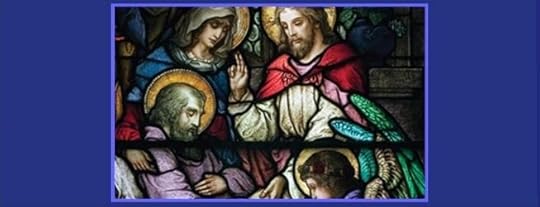Carl E. Olson's Blog, page 122
November 14, 2013
New: "Into All Truth: What Catholics Believe and Why"
Now available from Ignatius Press:
Into All Truth: What Catholics Believe and Why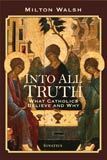
by Milton Walsh
Into All Truth presents the basic beliefs of the Catholic Church, beginning with the Resurrection. That extraordinary event prompted Jesus' followers to reflect on his identity and mission, which in turn led them to see the one God as an eternal communion of Father, Son and Holy Spirit. The Good News of the Catholic Church is that God invites every man and woman into this communion.
With extensive use of the Bible, the Catechism of the Catholic Church, and the documents of the Second Vatican Council, Into All Truth explains clearly and succinctly the dogmas of the Catholic Church that flow from her faith in the Trinity. Each dogma is traced back to the faith of the first followers of Jesus, and its development over time is explored.
Each chapter also outlines the implications of a given belief. The Resurrection, for example, has as much to say about human destiny as about the ultimate fate of Jesus.
This book is intended for the general reader, Catholic and non-Catholic alike. An online study guide is available for use with this book. It is an ideal way for young adults, and older adults as well to deepen their understanding of the Catholic faith.
Milton Walsh holds a doctorate in Sacred Theology from the Gregorian University in Rome. For many years he taught theology at St. Patrick's Seminary in Menlo Park, California. He is the author of In Memory of Me: A Meditation on the Roman Canon and Second Friends: C.S. Lewis and Ronald Knox in Conversation.
Praise for Into All Truth:
"Decades of turmoil have left many Catholics in a state of suspension. They aren't sure what the Church teaches and what they are to believe. They will not find a better resource than Milton Walsh's latest book, written precisely with these 'suspended' Catholics in mind."
- Karl Keating, Founder, Catholic Answers
November 13, 2013
"Jack": Convert, "Mere" Christian, and Near Catholic
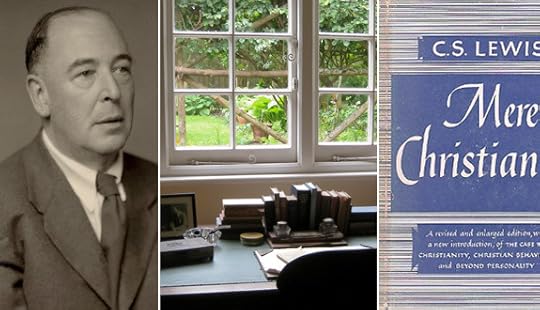
"Jack": Convert, "Mere" Christian, and Near Catholic | Michael Coren | CWR
The books and stories of C.S. Lewis, who died fifty years ago this month, continue to engage minds and capture hearts
He liked to be called Jack. Plain Jack.
But Clive Staples Lewis, arguably the greatest communicator of the Christian message in the 20th century, was anything but plain. He died on November 22, 1963, the same day as Aldous Huxley and President Kennedy, and while Lewis never completed the journey from Anglican to Catholic, he was well on the way; according to his last secretary Walter Hooper – whom am I proud to call a good friend – it was inevitably and only a matter of time.
Although evangelicals have adopted him as one of their own, this sacramental, liturgical Christian who smoked and drank was always a Catholic at heart. He wrote Mere Christianity, The Screwtape Letters, Surprised by Joy, and The Lion, The Witch and The Wardrobe, among so many other titles. Several of his Narnia books have been made into movies, and commercialism being what it is, there is now a thunderstorm of books and videos. But it is a sweet rain and in this case it is a joy to be made wet. Lewis would have laughed at such antics, always considering himself to be an ordinary teacher and an ordinary Christian.
In fact, Lewis was a most extraordinary teacher. A lecturer at both Oxford and Cambridge, he was considered one of the finest minds of his generation by fellow professors. His English Literature in the Sixteenth Century Excluding Drama and The Allegory of Love are still considered to be academic masterpieces. But it is Lewis the Christian who changed the world. His genius was the ability to convey highly complicated and complex ideas in a straightforward and understandable manner. Like some grand knight of common sense he charged through the ranks of cluttered thinking, double-talk, and atheism, seldom taking any prisoners.
Lewis declared himself a Christian in 1929, “perhaps the most dejected and reluctant convert in all England.” It was as though he had tried to avoid the inevitable, considering every argument against Christianity, forcing himself to take on all of the objections his fertile mind could produce. Each one he overcame. By the time his intellect was well and truly won over his emotional being simply fell into place. From this point on everything he wrote was informed and enlivened by his Christianity. But Lewis was too subtle and too clever to knock people over the head with his faith. He knew that talking was far more effective than shouting.
November 12, 2013
The Divine Gift of “Shalom” in a Good Death
The Divine Gift of “Shalom” in a Good Death | Marc Tumeinski | Homiletic & Pastoral Review
The truth, reality, gift, and desire of shalom make up a thread running through all of Scripture, throughout our whole Christian faith life, through the Mass, and through all of the sacraments.
As the sun was going down, a deep sleep fell on Abram; and lo, a dread and great darkness fell upon him. Then the LORD said to Abram, “Know of a surety that your descendants will be sojourners in a land that is not theirs, and will be slaves there, and they will be oppressed for four hundred years; but I will bring judgment on the nation which they serve, and afterward they shall come out with great possessions. As for yourself, you shall go to your fathers in peace; you shall be buried in a good old age. … ” On that day the LORD made a covenant with Abram. (Gn 15:12-15, 18a)
Introduction
“You shall go to your fathers in peace” (Gn 15:15). 1 How many times have we said or heard at a funeral or wake, “she looks so peaceful,” “now finally he is at peace.” These sentiments point us to a truth of our shared faith as Christians, and to the roots of the faith shared with our Jewish brothers and sisters. We might rightly call this truth the peace of a good and holy death, or in Old Testament language, the shalom 2 of a good death. Such peace we believe is a gift from the one good giver—our God and Father, merciful and almighty. What is this shalom? Where do we as Christians find the shalom of a good death in eternal life with God?
Shalom is rightly understood as “peace,” but this simple noun barely hints at the depth, power, and beauty of this biblical concept. (The Hebrew shalom and the Greek eirene are mentioned almost 700 times in the entire Bible. For simplicity’s sake, I will use the single term “shalom” but intend that to represent the Hebrew shalom and its variants, as well as the Greek eirene and its variants). Throughout Scripture, shalom is variously described as concord between peoples; seeking the good of a country or even a city; praying for the welfare of other people; physical safety; a good death; material prosperity; and spiritual well-being. 3 Shalom is associated with love, justice, truth, wholeness, and rightness. 4 Shalom is not merely the absence of conflict, but it is positively characterized in Scripture by such things as good relations between neighbors, as well as between enemies, freedom of worship, abundance, prosperity, and security among all peoples. For the Christian, shalom is seen as a gift of God and a fruit of the Holy Spirit, but also something for which we must work.
The truth, reality, gift, and desire of shalom make up a thread running through all of Scripture, throughout our whole Christian faith life, through the Mass, and through all of the sacraments. Pope Emeritus Benedict XVI points out that one of the names used by the early Church for the Eucharist—the Bread which we receive at Mass—was pax, which means peace.
Multiple Parents in a “Brave New World”

Multiple Parents in a “Brave New World” | Fr. James V. Schall, SJ | CWR
This new world began not in the scientific laboratory, but in the minds and desires of men.
I.
Recently,
the California governor signed a law whereby children could legally have not
just two, but three parents at the same time. This is the fifth state, plus the
District of Columbia, to have such legislation. The law is proposed, naturally,
under the rubric of “helping the child,” of keeping him out of a foster home.
Whether giving a child two “parents” of the same sex is good for the child in
the first place is likewise not brought up. The bill was not clear about who
will have authority when there is a conflict among the three parents about some
course of family action. Will it require a unanimous vote or only a 2-1
majority?
Nor was
there argument over the dubious notion that a single person, or even a couple,
has an individual “right” to a child. The first question is not about a “right”
of a single person or of parents but of their duty to the good of a child. The
focus of our thinking on this issue should be on marriage and its nature.
Children are gifts, not results of “rights.” “Rights” look to something
supposedly inherently “due” to an individual—something that one can demand
others to provide. A man and a woman are free to marry each other. What
marriage is means that their relationship can result in a child. But the child
is his own being. He is not simply a “planned product” of parents with “rights”
to him. The child must be considered at all stages of his being to be for his
own good, to which parents are ordered. The parents’ good is a result, not a
cause, of this good.
The issue
behind the new law had to do with a lesbian couple who decided to have a child,
something they obviously knew they could not have by themselves. Needless to
say, they had, as such, some insurmountable difficulty in carrying out this
“intention.” Their relationship, such as it is, can never result in a child who
is the produce of their exchanges. They can only have a child by an “imitation”
of what a real marriage between a man and a woman is.
November 11, 2013
"Saint Martin of Tours and the Search for Holiness" by Régine Pernoud

Saint Martin and the Search for Holiness | Régine Pernoud |
Prologue to Martin
of Tours
November 11 is now a red-letter day on the French civil calendar: in 1918
that date marked the end of the slaughter that was the First World War.
But even before France was called France, that date, the eleventh of November,
had been a date on the calendar used throughout Christendom because it
commemorated the burial at Tours of the amazing individual whom we call
Saint Martin.
 He
He was an amazing and even a paradoxical man: he never accomplished what
he had hoped to do, and yet his accomplishments surpassed all possible
expectations. To begin with, this man, who had always tried to go unnoticed,
enjoyed extraordinary popularity. He wanted to be a hermit, to flee the
world and devote himself to ascetical practices; instead he was constantly
surrounded by people, during his lifetime and after his death: the pilgrimage
shrine of Saint Martin in Tours was once the most important after the
three great pilgrimage sites of Christianity, Jerusalem, Rome, and, later
on, Saint James of Compostela. He is remembered as a soldier, and indeed
he was one, albeit entirely against his will. He had refused to be ordained
a priest, considering himself unworthy, and yet he became a bishop. He
had fled the world and sought a life of seclusion, but instead his biography
was written while he was still living!
Thanks to those who discerned the extraordinary qualities in this rather
reticent, unassuming man who resolutely practiced poverty, we know the
story of his life. It spans the fourth century, in which the Church became
free at last to live above ground, only to be torn by dissension so widespread
that it almost brought her to ruin.
There are not many individuals whose biographies were written during the
fourth century, especially during their lifetime. This was the case, however,
with Martin of Tours, thanks to his friend Sulpicius Severus, who survived
him long enough to record for us also the story of his death. And so we
have the unusual good fortune of possessing a contemporary document to
tell us about a man who, throughout his life, sought only to live among
his peers, in obscurity.
In Search of Holiness
Sulpicius Severus was handsome, young, and rich. He lived in Bordeaux,
a particularly prosperous town in the fourth century, where he received
an outstanding education; he practiced law there and excelled in his profession
because of his great eloquence. His family belonged to that Gallo-Roman
aristocracy which enjoyed the favor of the Roman emperors because their
power depended upon it. Thus, in the region that would later be called
Aquitaine, there were several families that owned enormous estates and
a large number of slaves and were extremely wealthy. The province was
crossed by navigable waterways, which guaranteed abundant commerce. Bordeaux
at that time had the reputation of being an "intellectual" city; like
Toulouse, it had quite a number of citizens who had conformed completely
to the customs and tastes characteristic of the Roman Empire. In the region
surrounding Toulouse archeologists have found as many busts and sculptures
from the imperial era as they have in the vicinity of Rome–artwork
intended to ornament the villas where these opulent families lived.
Sulpicius Severus, being a lawyer, had made a name for himself in "upper-middle-class"
circles while he was still a very young man. His reputation is inseparable
from that of the man who would later be called Paulinus of Nola, with
whom he was bound by ties of friendship. Paulinus, a lawyer like Sulpicius,
came from an even richer family than his and was likewise an avid man
of letters. It is easy to imagine the two friends going together to the
thermal baths or attending the literary gatherings of the day, where people
discussed the poetry of Virgil or Ovid, or perhaps the eloquence of Cicero.
Paulinus, who was highly valued by Emperor Valentinian II, had been appointed
for a time as governor of Campania, but he had resigned from his official
duties and returned to Bordeaux so as to lead there a life of elegant
leisure, as was the fashion then on the banks of the Garonne River.
Now a new factor came into his life around the year 389 (Paulinus was
about thirty-six years old at the time): he was touched by the gospel.
The Christian religion, which had been spreading freely for a good sixty
years–the Edict of Milan promulgated by Constantine, which ended
the persecutions, dated back to the year 313–would thoroughly transform
that pleasure-seeking aristocrat. In the year 390, together with his wife,
Therasia, he received baptism. His encounter with the Christian faith
may have been fostered by the great sorrow he had experienced at the death
of a beloved brother.
Soon afterward, Sulpicius in turn was touched by grace. He had been married
only a little while, and perhaps his motherin-law, Bassula, who was a
fervent Christian, had had some influence upon him. He received baptism,
but his wife died shortly after, and he found himself disowned by his
father, who could not abide his conversion. Moreover, Sulpicius himself
was preparing to follow the example of his friend Paulinus, who had begun
to divest himself of all his property, following the evangelical counsel
of poverty to the letter. Of what he inherited from his wife, Sulpicius
kept only a small lot, a kind of temporary lodging, where from then on
he would welcome a number of other Christian converts who wished to lead
a life of prayer and asceticism. The place was called Primullacum in Latin,
and it has been identified with the little city of Alzonne on the road
from Toulouse to Carcassonne, not far from Brain, in the Aude in Languedoc.
Sulpicius must have taken up residence there in 394 or a little earlier.






It was there, too, that he received the letters that
Paulinus wrote to him. For example, the one in which he expresses, in
the rather emphatic language of that era, his admiration for his young
friend:
But you, my most beloved brother, were converted to the Lord by a
greater miracle [than I]. For you were closer to your prime, you were
winning greater eulogies, the burden of your inheritance was lighter,
yet you were no poorer in store of wealth; you were still prominent in
the fame of the forum which is the theatre of the world, and you held
the palm for glory of eloquence. Yet with a sudden urge you shook off
the slavish yoke of sin, and broke the deadly bonds of flesh and blood.
Neither the additional riches brought by your marriage into a consular
household nor the easy tendency to sin after your marriage [i.e., after
he was widowed] which followed your celibate youth could draw you back
from the narrow entrance to salvation, from the steep path of virtue to
the soft, broad road trodden by many. [1]
And Paulinus continues, recalling the friendship that united them in their
youth:
What shall I render to the Lord for this grace in addition to all
his bounty to me? (Ps 115 [116]:12). For through this grace He has
joined you to me not only as a most beloved friend in our earlier life
in the world, but also as an inseparable companion and partner in the
spiritual brotherhood of His affairs.... [T]hat intimate friendship of
our earlier life, when we still loved the things which we now reject in
Christ, marked us out for each other in the love of Christ. [2]
Paulinus had returned with his wife to Campania, where he settled at Nola,
a little town founded of old by Saint Felix, who was buried there. From
then on Paulinus and his wife led a very austere life, dwelling in the same
house but living as brother and sister, and devoting themselves to the needs
of the pilgrims and the poor. Paulinus had already been ordained a priest
in Barcelona, and in 409 he was appointed bishop of Nola. In another one
of his letters to Sulpicius he writes: "You revealed the increase of your
inheritance amongst the saints. This you did by your wholesome disposal
of the burdens of this world, for you have purchased heaven and Christ at
the price of brittle worldly goods," [3] Thus the correspondence between
the two friends leaves no doubt as to their complete conversion, which led
both of them to give away their fortunes. It is said that even Sulpicius,
who retained his ownership of Primuliacum, only did so in order to host
friends there, as well as his mother-in-law, with whom he maintained close
ties of friendship and whose fervent faith was evident. He experienced scruples,
however, on that account, and Paulinus reassured him:
And why should you lament that you on the contrary are still unhappily
clinging to the slimy dregs of hell below, just because from your letter
you appear not to have sold one petty estate? Your forfeiture of your
present right even to that farm is equivalent to selling it, so that by
the greater fruits of your faith you showed to God a twofold dedication
... for the goods you have kept back are possessed by the church which
you serve. [4]
Sulpicius Severus, while in retirement on his estate, received many visitors,
and that is how he heard about the bishop of Tours, Martin.
As for Paulinus, even before his conversion he had been in contact with
Martin. Later on Sulpicius would tell of the circumstances. "A man named
Paulinus, who was afterwards to be an example to all, had begun to suffer
from acute pain in one eye and a fairly thick film had by now grown over
the pupil. Martin, by touching the eye with a fine paintbrush, restored
it to its former state and at the same time banished all the pain." [5]
This probably took place during a journey that Martin made to Vienne, and
it is conjectured that the two friends must have had an ongoing discussion
about this cure.
But this was certainly not the only reason that prompted Sulpicius to go
to see Martin. Plainly, the reputation of the bishop of Tours had aroused
his curiosity even before that. " 11 had previously heard accounts of his
faith, his life, and his powers and burned with the desire to know the man
himself", he writes. "I therefore undertook as a labor of love a pilgrimage
to see him." Indeed, in those days the journey from the regions along the
Garonne River to the banks of the Loire River was long. Traveling from north
to south was easy through the Saône and Rhône valleys, but that
was not the case in the western territories that drain into the Atlantic
Ocean; furthermore, the Roman roads crossed France from east to west.
"At the same time," Sulpicius relates, I was all on fire to write his life."
His natural talents would find expression in a literary work that was perfectly
suited to his deep feelings. He decided, therefore, to make the journey.
"You would never credit the humility and kindness with which [Martin] received
me on that occasion. He congratulated himself and praised the Lord because
I had thought so highly of him that I had undertaken a long journey especially
to see him." And he tells of his embarrassment when Martin invited him to
share in a meal, and "it was he who fetched the water for me to wash my
hands and, in the evening, it was he who washed my feet. Nor had I the courage
to remonstrate or resist. I was so overcome by his authority that I would
have felt it impious to do anything but acquiesce."
No doubt this visit made a profound impression on Sulplcius. He found in
Martin just as saintly an individual as he had been said to be. "But all
his talk while I was there was of the necessity of renouncing the allurements
of the world and the burdens of secular life in order to follow the Lord
Jesus freely and unimpeded." And the following lines suggest even more the
extent to which the conversations with Martin must have affected his guest:
indeed, Martin held up Paulinus to him as an example! "He quoted as an outstanding
example in our own day the case of his Excellency Paulinus, whom I mentioned
earlier. He had abandoned immense wealth to follow Christ and was almost
alone in our times in fulfilling the evangelical counsels. 'There,' Martin
kept exclaiming, 'there is someone for you to follow."' We can surmise that
his words elicited an emotional response from his interlocutor! Martin drew
from the decision of Paulinus a lesson for his generation: "For a rich man
with great possessions, by selling all and giving to the poor, had illustrated
Our Lord's saying, that what is impossible to do is in fact a possibility."
After that memorable encounter, Sulpicius was able to undertake what would
be the great accomplishment of his life: writing the life of Martin of Tours.
It took nothing less than the call of the gospel and the power of the faith
to draw together two men who were so dissimilar, from such different social
backgrounds.
Endnotes:
[1] Ancient Christian Writers Series, Letters of St. Paulinus of Nola,
trans. and annot. by P. G. Walsh, vol. 1 and 2 (Westminster, Md.: The Newman
Press, 1966-1967). The citation is from vol. 1, Letter 5, par. 5, pp. 56-57.
[2] Ibid., vol. 1, Letter 11, par. 1, 5, pp. 90, 93.
[3] Ibid., vol. 1, Letter 1, par. 1, pp. 29-30.
[4] Ibid., vol. 1, Letter 24, par. 1, p. 51.
[5] As indicated in the Acknowledgments, all quotations from the writings
of Sulpicius Severus are quoted from the translation by F. R. Hoare, in
The Western Fathers: Being the Lives of SS. Martin of Tours, Ambrose, Augustine
of Hippo, Honoratus of Arles and Germanus of Auxerre (New York: Sheed
& Ward, 1954). Reprinted by kind permission of Sheed & Ward (U.K.),
an imprint of the Continuum International Publishing Group.–TRANS.
Régine Pernoud, a renowned French archivist and historian, is among
the greatest medievalists of our times, and the success of her books has
helped to bring the Middle Ages closer to us. Among her numerous works are
Those
Terrible Middle Ages!, The
Crusaders, and Women in the Days of the Cathedrals.
Blockbuster film "Restless Heart" available Nov. 15th on DVD
Ignatius Press announces release of highly anticipated movie on St. Augustine
SAN FRANCISCO, Nov. 11, 2013 – The wait is over. Ignatius Press will release RESTLESS HEART: The Confessions of Augustine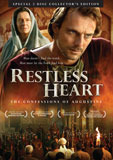 , the first full-length feature film on beloved St. Augustine, as a two-disc collector’s edition DVD Friday, Nov. 15, 2013. The highly anticipated DVD features the 133-minute theatrical-length film and a 203-minute extended version of the film, and a 24-page illustrated companion booklet.
, the first full-length feature film on beloved St. Augustine, as a two-disc collector’s edition DVD Friday, Nov. 15, 2013. The highly anticipated DVD features the 133-minute theatrical-length film and a 203-minute extended version of the film, and a 24-page illustrated companion booklet.
Filmed in Europe, RESTLESS HEART uses a historic backdrop to tell the story of one of the Church’s most beloved and well-known saints. Its message of sin, conversion and redemption is as timely today as it was in the fifth century of Augustine. It is the story of a gifted man who pursues fame and fortune without a moral compass — and the dramatic changes that occur in his soul when challenging events lead him to see the light of truth. It also chronicles the collapse of the Roman world and how Augustine laid the intellectual foundations of what became Europe. With Augustine, the stories of two other great saints, Monica and Ambrose, are also portrayed.
“The release on DVD of RESTLESS HEART is a major event for Ignatius Press, as this epic film is the biggest movie project we have been involved with to date,” said Ignatius Press Director of Marketing Anthony Ryan. “For the first time ever, with this film IP did a three-stage release process: an eight-month sponsored-theatrical release, then a five-month parish screening program release, and now the third and final stage, releasing it on DVD in a special two-disc Collector's Edition. The positive response of the public to this powerful film on St. Augustine has been overwhelming, and we are very excited to now release it on DVD, just in time for the Christmas season.”
RESTLESS HEART is directed by Christian Duguay (“Joan of Arc,” “Pius XII”). The cast includes Allesandro Presiosi, Monica Guerritore, Johannes Brandrup, Serena Rossi and Franco Nero.
Ignatius Press originally obtained the North American distribution rights to the movie and made it available via a screening program that was immensely successful; it resulted in over 1,000 screenings in over 200 cities in North America, with large crowds frequently attending each show.
For more information on the DVD, or to schedule an interview with Anthony Ryan, please contact Kevin Wandra (404-788-1276 or email KWandra@CarmelCommunications.com) of Carmel Communications.
Here is an exclusive, extended trailer of the film:
New: "Faith, the Fount of Exegesis: The Interpretation of Scripture in the Light of the History of Research on the Old Testament"
Now available from Ignatius Press:
by Ignacio Carbajosa
This book is a response to a desire expressed by the then Cardinal
Joseph Ratzinger (the future Pope Benedict XVI) who called for a
diachronic study of the results of the historical-critical method. The
study of the last 150-200 years of biblical research shows how the claim
to scientific rigor made in many works, that is, the claim to have
obtained results comparable in their certainty to 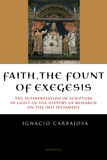 those of the natural
those of the natural
sciences, is clearly unrealistic.
This is a comprehensive analysis of the results of almost two centuries
of the historical-critical method in two areas: the investigation into
the sources of the Pentateuch and the study of the figure of the
prophet. It reveals the philosophical and cultural presuppositions which
influenced the development of exegesis and it's most notable
hypotheses, demonstrating the world of prejudices which frequently have
conditioned the exegesis called "scientific".
It also engages the characteristic dimensions of the Catholic
interpretation of the Old Testament, attempting to unify the two basic
dimensions of the exegetical method: history and theology. Overcoming
the disconnect between "scientific" exegesis and "believing" theology is
one of the great contemporary challenges to the intellectus fidei. This
dualism cannot be overcome simply by a call to greater devotion or the
generous intention of adding pious commentary to an exegesis which has
not, from the beginning, been based on faith.
This book provides a positive contribution to the hermeneutical problem
at the heart of current exegetical debate, the status of exegesis,
addressing such questions as: Does exegesis have a theological
character? Should it have one? If it does have one, would it not then
lose its scientific character? Thus one arrives at the main question:
how can one conceive of an exegesis that is at the same time critical
and theological? How can faith be the foundation of exegesis from the
beginning? Could Faith really be the "Fount of Exegesis"?
Ignacio Carbajosa, Ph.D. in Biblical Studies from the
Pontifical Biblical Institute, is a Professor of Old Testament and
Semitic Languages at the San Dámaso University in Madrid. He is the
editor in chief of the journal Estudios Bíblicos, a member of the Society of Biblical Literature, and author of numerous books on Scripture including The Character of the Syriac Version of Psalms and A Scribe in the King's Court: Read the Old Testament from Christ.
November 9, 2013
Faith, Hope, and Heaven
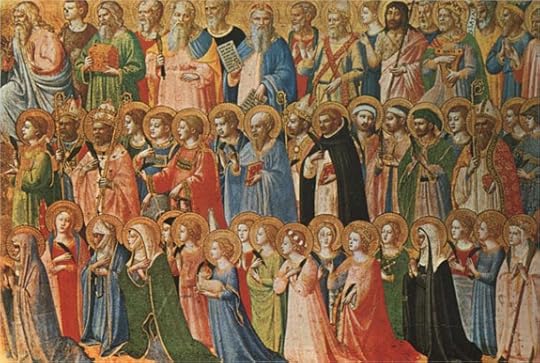
"Christ Glorified in the Court of Heaven" by Fra Angelico (1428)
A Scriptural Reflection on the Readings for Sunday, November 10,
2013 | Carl E. Olson
Readings:
• 2 Mc 7:1-2, 9-14
• Ps 17:1, 5-6, 8, 15
• 2 Thes 2:16-3:5
• Lk 20:27-38
“Let us
put it very simply: man needs God, otherwise he remains without
hope.” That statement by Benedict XVI, made in his 2007
encyclical, Spe Salvi (“Saved In Hope”), serves well as a prologue to today’s
readings. Each has something to say about the virtue of hope, which
is, the Holy Father notes, closely intertwined with the virtue of
faith, “so much so that in several passages the words ‘faith’
and ‘hope’ seem interchangeable.”
Both 1 and
2 Maccabees describe the Jewish struggle against the political
domination and religious suppression inflicted, first, by the
Ptolemaic dynasty of Egypt and, later, by the Seleucid dynasty of
Syria. The story from 2 Maccabees of the seven brothers took place
sometime in the early to mid-second century B.C. The story
demonstrates, rather dramatically, that some just Israelites would
rather die than renounce or “transgress the laws of our ancestors.”
This resolve was based in their belief that “the King of the
world”—that is, God—“will raise us up to live again forever.”
One of the brothers spoke directly and passionately about his hope of
“being raised up by him”, while flatly declaring that his
oppressors would not experience resurrection from death to life.
The
passage’s description of martyrdom and the Jewish belief in a
future resurrection of God’s faithful ones, provides some helpful
context for Jesus’ teachings about the afterlife. The Sadducees
were an influential group that arose within Palestinian Judaism
around the time recorded in 2 Maccabees. During Jesus’ earthly
life, the high priest and the temple authorities were Sadducees (Acts
4:1; 5:17). They were distinguished by a staunch, even radical,
adherence to the laws of Moses alone; they believed the Torah did not
allow for or teach the resurrection from the dead, a belief held by
the Pharisees.
The
Sadducees presented a dilemma to Jesus based on the levirate law
(Deut. 25:5), which stated that if a married man died childless, his
brother was obligated to marry his widow. Jesus pointed out there is
no marriage in the afterlife because there is no death or procreation
in that state. He then went to the heart of the matter, which had to
do with God’s nature. Having called out to Moses from the burning
bush, God declared: “I am the God of your father, the God of
Abraham, the God of Isaac, and the God of Jacob.” pointed out that
those men “all are alive” to God, for he is the source and
realization of an eternal hope.
The
Bible is the story of God calling man
out of sin and to his eternal home. Throughout the Old Testament
there is a growing awareness of a hope for the Kingdom of God and an
eternal, perfect covenant to be established by the Messiah. While
always rooted in dependence upon God and His promises, that hope
often focused on material prosperity and freedom from oppression.
This hope was strongly connected to wisdom, which is a trusting
knowledge of God’s goodness and faithfulness. “Know that wisdom
is such to your soul,” wrote the author of Proverbs, “if you find
it, there will be a future, and your hope will not be cut off”
(Prov. 24:14). There was a gradual realization of an afterlife beyond
the earthly realm. “Hope in the bodily resurrection of the dead
established itself as a consequence intrinsic to faith in God as
creator of the whole man, soul and body” (CCC,
992).
Hope
is central to the Christian life. It is also distinctive, a mark of
the uniqueness of the Christian view of life, death, and history. The
Church has always taught that if death was not and cannot be
conquered, there is no hope. And if there is no hope beyond this
temporal realm, there is no meaningful life in this world. Any vision
of life that ignores the reality of mortality cannot be a source of
authentic hope, for such hope is a grace and a source of everlasting
encouragement.
(This "Opening the Word" column originally appeared in the November 7,
2010, issue of Our Sunday Visitor newspaper.)
November 8, 2013
New: "Witnesses to Mystery: Investigations into Christ's Relics"
Now available from Ignatius Press:
Witnesses to Mystery: Investigations into Christ's Relics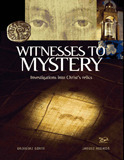
by Grzegorz Gorny
336 pages | Hardcover
In this lavishly illustrated large coffee-table volume, writer Gorny and
photographer Rosikon embarked on a two year investigative journey to
seek the truth behind all the relics associated with the passion of
Christ. The authors investigated a rich body of documentary evidence
found in various museums, archives and churches surrounding sacred
objects believed to have been preserved since Jesus' lifetime, exploring
and collaborating with historians and scientists in their attempt to
verify the relics' authenticity. They reach their conclusions not so
much on the basis of faith as on the evidence supplied by historical
sources and expert scientific opinion.
The relics associated with the Passion - the suffering, death and burial
of Christ - have long proved something of an enigma for the scientific
community. Relics investigated, and photographed, for this glorious
volume include: the Cross, nails, crown of thorns, pillar of scourging,
Christ's tunic, the Veil of Manoppello, the Sudarium of Oviedo, the
famous Shroud of Turin burial cloth and more.
Grzegorz Górny is a reporter, essayist, and film and
television producer. He is the founder and editor-in-chief of the
quarterly Fronda, and from 1994 to 2001 he co-authored a program under
the same title that aired on the Polish national television. He has
produced various documentary television series and authored numerous
articles for European publications. His books include Battle for Madrid (2010).
Janusz Rosikon is a photographer and a member of the
Polish Journalists' Association and the Association of Polish Artistic
Photographers. His photographs have been featured in Time, Newsweek, and Reader's Digest
and various European publications. His work has been exhibited in
public galleries in Poland, England, Austria, and North America.
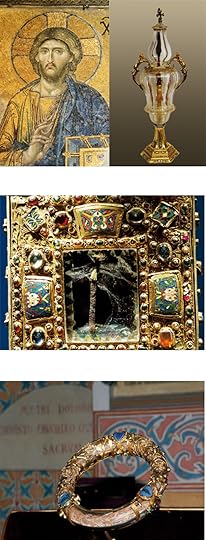
Evangelization: It’s Not Just For Protestants
How to Share Your Faith with Anyone: A Practical Manual of Catholic Evangelization
(Also available in Electronic Book Format)
"God has created me to do Him some definite service; He has committed some work to me which He has not committed to another. I have my mission." — Blessed John Henry Cardinal Newman [image error]
‘‘To bring to light [for all] what is the plan of the mystery hidden from ages past in God . . . so that the manifold wisdom of God might now be made known through the church’’ (Eph 3:9–10).
Union with priests and bishops is crucial:
‘‘Obey your leaders and submit to them; for they are keeping watch over your souls, as men who will have to give account’’ (Heb 13:17, RSV).
Carl E. Olson's Blog
- Carl E. Olson's profile
- 20 followers


